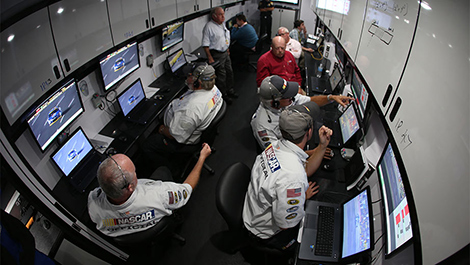Jan
16th
Stay connected Subscribe to our RSS feed
From nascar.com
NASCAR officials will no longer be standing alongside crewmen to police pit stops in 2015.
A new, technologically driven system that incorporates the use of 45 cameras will feed video of every stop made by every team to a central location, where eight officials will log pertinent information and report any violations.
Each of the cameras will display two specific pit stalls. Once a car is on pit road, the individual cameras will record its progress as it moves through each area. The use of tracking software and pit road scoring loops identifies and verifies each car.
That same system software tracking its movement will indicate any infractions, such as too many men over the wall or driving through too many pit boxes when entering or exiting the pits based on information ingested before the event.
If there are no infractions logged by the system, one of the eight officials will still monitor the stop, noting the number of tires taken, whether fuel was added and whether any changes (chassis adjustments or repair to a damaged area, for example) to the car were made.
Infractions fall into three groups -- vehicle (such as pitting outside pit box), equipment (leaving pit box with gas can still attached, etc.) and personnel/crew (too many men over the wall; over the wall too soon, etc.).
When the software picks up an infraction, it will be displayed on the monitor where an official will quickly view the stop and either confirm the issue (and subsequently notify the tower) or clear it if it can be determined that no infraction took place.
The use of the technology will change the number of officials along pit road. Instead of the approximately two dozen that policed pit stops last year, only 10 will be in the pits this year. They would be stationed behind pit wall where they can respond to any team inquiries and monitor actions from that side of the car when necessary.
Although it was in place during the final portion of the 2014 season, the system was tested, but not used for official purposes.
NASCAR officials will no longer be standing alongside crewmen to police pit stops in 2015.
A new, technologically driven system that incorporates the use of 45 cameras will feed video of every stop made by every team to a central location, where eight officials will log pertinent information and report any violations.
Each of the cameras will display two specific pit stalls. Once a car is on pit road, the individual cameras will record its progress as it moves through each area. The use of tracking software and pit road scoring loops identifies and verifies each car.
 |
| Eight NASCAR officials will now report pit stop violations. (Photo: NASCAR) |
That same system software tracking its movement will indicate any infractions, such as too many men over the wall or driving through too many pit boxes when entering or exiting the pits based on information ingested before the event.
If there are no infractions logged by the system, one of the eight officials will still monitor the stop, noting the number of tires taken, whether fuel was added and whether any changes (chassis adjustments or repair to a damaged area, for example) to the car were made.
Infractions fall into three groups -- vehicle (such as pitting outside pit box), equipment (leaving pit box with gas can still attached, etc.) and personnel/crew (too many men over the wall; over the wall too soon, etc.).
When the software picks up an infraction, it will be displayed on the monitor where an official will quickly view the stop and either confirm the issue (and subsequently notify the tower) or clear it if it can be determined that no infraction took place.
The use of the technology will change the number of officials along pit road. Instead of the approximately two dozen that policed pit stops last year, only 10 will be in the pits this year. They would be stationed behind pit wall where they can respond to any team inquiries and monitor actions from that side of the car when necessary.
Although it was in place during the final portion of the 2014 season, the system was tested, but not used for official purposes.
 The latest auto news, reviews, prices, product and vehicle releases.
The latest auto news, reviews, prices, product and vehicle releases.